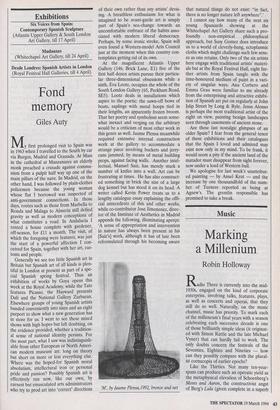Exhibitions
Mudanzas (Whitechapel Art Gallery, till 24 April) Desde Londres: Spanish Artists in London (Royal Festival Hall Galleries, till 4 April)
Fond memory
Giles Auty
My first prolonged visit to Spain was in 1963 when I travelled to the South by car via Burgos, Madrid and Granada. At Mass in the cathedral at Manzanares an elderly monk preached a crusade against commu- nism from a pulpit half way up one of the main pillars of the nave. In Madrid, on the other hand, I was followed by plain-clothes policemen because the young woman whose flat I borrowed was suspected of anti-government connections. In those days, routes such as those from Marbella to Ronda and Malaga to Almeria still defied gravity as well as modern conceptions of what constitutes a road. In Andalucia I rented a house complete with gardener, off-season, for fl 1 a month. The visit, of which the foregoing were features, was just the start of a powerful affection I con- ceived for Spain, together with her art, cus- toms and people. Generally we see too little Spanish art in Britain but Spanish art of all kinds is plen- tiful in London at present as part of a spe- cial Spanish spring festival. Thus an exhibition of works by Goya opens this week at the Royal Academy, while the Tate features Picasso, the Hayward presents Dali and the National Gallery Zurbaran. Elsewhere groups of young Spanish artists banded conveniently into sixes and an eight purport to show what a new generation has in store for us. I went to see these mixed shows with high hopes but left doubting, on the evidence provided, whether a tradition- al sense of national identity persists. For the most part, what I saw was indistinguish- able from other European or North Ameri- can modern museum art: long on theory but short on more or less everything else. Where was the hoped-for Spanish moral absolutism, intellectural iron or personal pride and passion? Possibly Spanish art is effectively run now, like our own, by earnest but emasculated arts administrators who try to prod art into 'correct' directions of their own rather than any artists' devis- ing. A breathless enthusiasm for what is imagined to be avant-garde art is simply part of Spain's sea-change towards an uncomfortable embrace of the habits asso- ciated with modern liberal democracy. Perhaps, by some ironic stroke, Spain will even found a Western-model Arts Council just at the moment when this country con- templates getting rid of its own.
At the magnificent Atlantis Upper Gallery (146, Brick Lane, El) five of the first half dozen artists pursue their particu- lar three-dimensional obsessions while a sixth, Eva Lootz, occupies the whole of the South London Gallery (65, Peckham Road, SE5). Lootz deals in installations which aspire to the poetic: the sawn-off bows of boats, saplings with metal hoops tied in their lengths, an apparently frozen broom. That her poetry and symbolism seem some- what inexact and verging on the arbitrary would be a criticism of most other work in this genre as well. Jaume Plensa meanwhile required extensive internal construction work at the gallery to accommodate a strange piece involving buckets and jerry- cans jammed, by means of metal building props, against facing walls. Another intel- lectual, Manuel Saiz, has merely stuck a number of knifes into a wall. Art can be frustrating at times. He has also construct- ed something in brick the size of a large dog kennel but has stood it on its head. A writer called Kevin Power treats us to a lengthy catalogue essay explaining the offi- cial antecedents of this and other works, while co-contributor Jose Jimenenez, direc- tor of the Institute of Aesthetics in Madrid appends the following, illuminating apercu: `A sense of appropriation and intervention in nature has always been present in his [Saiz's] work, although it has of late been reformulated through his becoming aware M, by Jaume Plensa,1992, bronze and net that natural things do not exist: "in fact, there is no longer nature left anywhere".'
I cannot say how many of the next six young Spaniards showing at the Whitechapel Art Gallery share such a pro- foundly non-empirical philosophical approach, but Susy Gomez does introduce us to a world of cleverly-hung, ectoplasmic cloths which might challenge such few sens- es as one retains. Only two of the six artists here engage with traditional artists' materi- als but at the Royal Festival Hall, eight fur- ther artists from Spain tangle with the time-honoured medium of paint in a vari- ety of singular ways. Ana Corbero and Emma Grau were familiar to me already from the enterprising and attractive exhibi- tion of Spanish art put on regularly at John Islip Street by Long & Ryle. Jesus Alonso is perhaps the most traditional artist of the eight on view, painting benign landscapes seen through casements of ancient stone.
Are these last nostalgic glimpses of an older Spain? I fear from the general tenor of these exhibitions and their catalogues that the Spain I loved and admired may exist now only in my mind. To be frank, it would seem a pity if the ancient land of the matador must disappear from sight forever, now under a load of Western bull.
We apologise for last week's unattribut- ed painting — by Ansel Krut — and the increase by one thousandfold of the num- ber of Turners reported as being at Agnew's. The gremlin responsible has promised to take a break.


























































 Previous page
Previous page